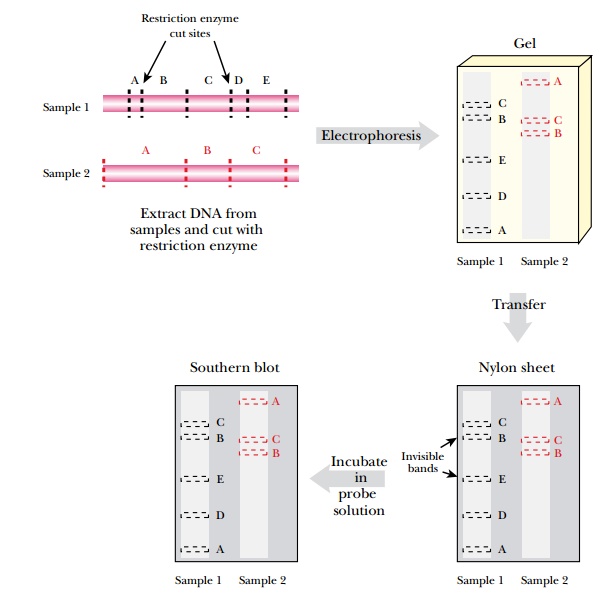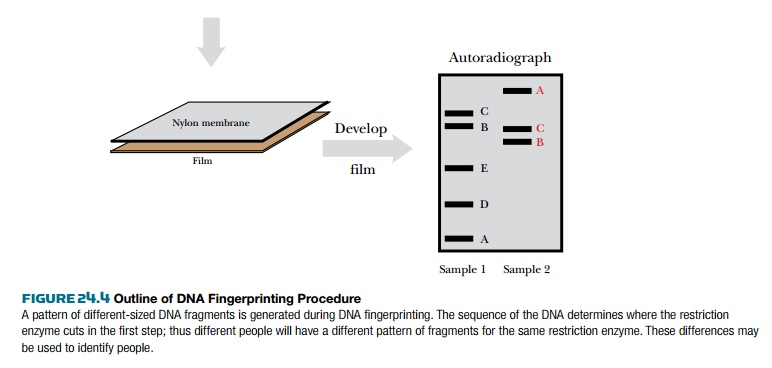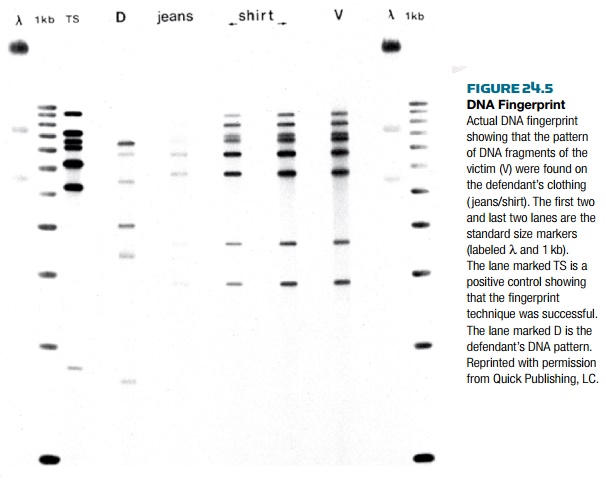Chapter: Biotechnology Applying the Genetic Revolution: Forensic Molecular Biology
DNA Fingerprinting
DNA FINGERPRINTING
DNA fingerprinting relies on
the unique pattern made by a series of DNA fragments after separating them
according to length by gel electrophoresis. DNA samples from different suspects,
the victim, and samples from the crime scene are first purified. Restriction
enzymes cut the DNA samples into fragments of different lengths. Consequently,
the variation in the size of the fragments and hence of their positions on an
agarose gel is due to differences in where cutting occurs. Thus differences in
patterns between individuals are due to differences in the base sequence of
their DNA. The nucleotide differences that cause the fragment lengths to vary
are called restriction fragment length polymorphisms. There is believed to be approximately one
difference in every 1000 nucleotides between nonrelated individuals.


The steps involved in DNA
fingerprinting are as follows ( Fig. 24.4 ):
1 . The DNA is cut with a restriction
enzyme.
2 . The DNA fragments are separated
according their length or molecular weight by gel electrophoresis.
3 . The fragments are visualized by Southern
blotting. After transfer of the separated fragments from the gel to nylon paper
a radioactively labeled DNA probe is added. The probe will bind to those DNA fragments
whose DNA sequences are complementary to the probe.
4 . An autoradiograph is made by covering
the blot with radiation-sensitive film. This will show the location of those
DNA fragments that reacted with the radioactive probe.
There are many different
restriction enzymes, most with unique cutting properties. In practice several
different enzymes are used with the same DNA samples, giving different sets of
fragments for different people. These can be compared with DNA samples taken from
a victim or found at a crime scene. Because there is so much genetic diversity,
RFLP patterns from different people can vary a lot. Even if mutations have
changed a small percentage of the target sequence around the cut site, there
will usually still be enough similarity for binding of the probe to occur. The
entire process requires several weeks to finish.

The final product of a DNA
fingerprint is an autoradiograph that contains at least five essential lanes (
Fig. 24.5 ). The markers are standardized DNA fragments of known size, which have
been radioactively labeled. These help determine the size of the various
fragments. The “control” is DNA from a source known to react positively and
reliably to the DNA probes and shows whether the test has worked as expected.
The experimental lanes have samples from the victim, the defendant, and the
crime scene. In this example, blood from the defendant’s clothing was compared
with his/her own blood and the victim’s blood. The DNA from the clothing actually
matches that of the victim.
Two variants of DNA fingerprinting have been used— single-locus probing (SLP) and multiple-locus probing (MLP) . In SLP, a probe is used that is specific for a single site, that is, a single locus, in the genomic DNA. Because humans are diploid, an SLP probe will therefore normally give rise to two bands from each person for each particular locus. This assumes that the chosen locus shows substantial allelic variation. Occasional persons will be homozygous and hence show only a single band. For full identification using SLPs, it is necessary to run several reactions, each using a different SLP probe. SLP analyses use smaller amounts of material than MLP and are easier to interpret and compare. Statistical analysis and population frequencies are possible using SLP data.
Historically, MLP was used before SLP.
In MLP, a probe is used that binds to multiple sites in the genome.
Consequently, an MLP probe generates multiple bands from each individual. Because
it is not known which particular band comes from which particular locus,
interpretation is difficult. Furthermore, statistical analysis is impractical
and data cannot be stored reliably in computer databases. In practice,
fingerprints generated by MLP probes must be directly compared with others run
on the same gel. Consequently, MLP methods have largely been displaced by SLP
analysis.
Related Topics